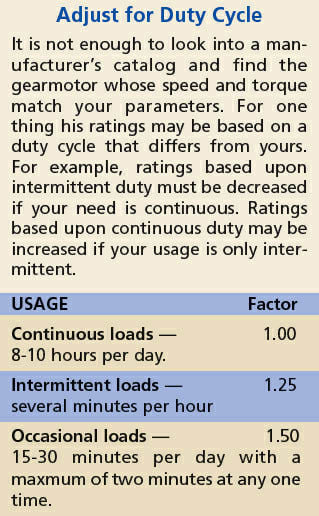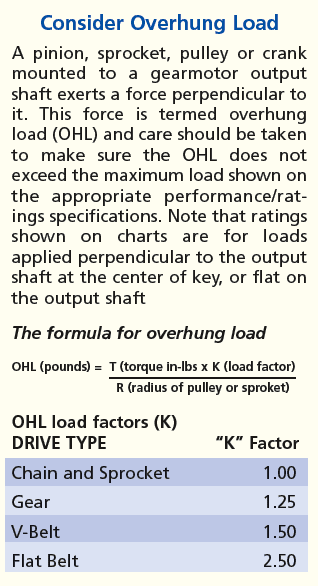
A custom gearmotor is one that meets your particular specifications. It has the correct mechanical and electrical interfaces, fits within the envelope available, meets your performance, maintenance, lifetime, and aftermarket criteria, and fits within your budget.
Many considerations are involved in specifying the correct gearmotor for your application. They run the gamut from AC or DC, single or three phase, PSC or split phase, PMDC or BLDC, TEFC or TENV, cord or flying leads, parallel shaft or right angle, stub or hollow shaft, keyed or splined, grease or oil lubrication, face or foot mount, just to mention a few. Determining your torque requirement, output speed, overhung load, duty cycle and environmental criteria all pose design engineering challenges.
If you’re designing equipment that will likely require thousands or gearmotors per year, then you should be working with a gearmotor supplier who can give you a truly custom solution that meets all your needs and for which you don’t have to pay extra for features or performance exceeding your engineering requirements.
Here are some useful guidelines for selecting custom gearmotors:

- Involve the Gearmotor Supplier Early in the Design Process: To the extent that you engage your gearmotor supplier’s application engineers early in your design cycle, you will ensure that you meet all of your specifications as well as your budget target. Skilled and experienced gearmotor application engineers can save you months of time. If brought in early, they can understand, and possibly even help you design your test protocol.
- Expect Custom Engineered Samples in a Reasonably Short Timeframe: It’s not unusual to see “next day samples” touted in marketing materials. On reading the fine print, though, that only applies to a limited variety of standard, catalog products. Say your application only requires slight modification to a standard item, such as shaft detail, cord or connector, gear ratio change, etc. It is not unreasonable to expect such prototypes can be turned around in a couple weeks or so. Changes to motor windings or designs, new gearheads, castings, or other truly custom solutions will take longer. A good gearmotor supplier will have the resources to significantly reduce leadtimes for prototypes. It is unnecessary to wait 16 weeks or more for a custom gearmotor prototype.
- Can They Scale-Up to Meet Your Volume?: If you are considering changing gearmotor suppliers on an existing high volume project, you need to know if they have a track record of successfully ramping up new, high volume business. They should also have the capability to quickly and effectively “reverse engineer” your existing gearmotor designs. A really good gearmotor supplier can engineer and deliver more than a dozen different gearmotor models that a customer may require to replace his old supplier, and ramp up to thousands of units per month within just a couple of calendar quarters.
- Consider Value-Added Capability: Your gearmotor supplier should be capable of working with you to provide more than just a gearmotor. Increasingly, companies are finding they can increase productivity, reduce inventories and facility requirements by working together with their gearmotor supplier to provide engineered subassemblies or assemblies. Your gearmotor supplier should be willing to work with you to supply your needs to the level of value you desire.
- Get to Know Your Gearmotor Supplier Team: Your gearmotor supplier will be an important element in your company’s supply chain and they should welcome a visit by you and your team. Take this opportunity to assess your gearmotor supplier’s facilities, personnel and quality procedures. In addition to their sales and marketing executives, you want to get to know their engineering, operations and other key executives and managers who will become an important part of your own extended team.
- Remember: It’s Your Specification and Your Business: Your gearmotor supplier should be willing to enter into a nondisclosure agreement with your company to protect the confidentiality of your work. You’ll find that the best gearmotor suppliers often dominate a particular market segment and continue to do so because of their discrete handling of confidential information while working for several competitors in a given market.
- Supplier Should Foster Strong Relationship: You will probably want to do business with a gearmotor supplier that is not only well-established and respected, but also one that builds longterm customer relationships. Keeping customers over periods of five, ten or twenty-five years or more signifies not only the ongoing viability of the gearmotor supplier, but also his commitment to continuous improvement and performance excellence markets. The best customer and gearmotor supplier relationships are based on knowledge and understanding of each other’s businesses. The customer should expect to be able to call any member of the gearmotor supplier team to solicit input, discuss issues, and work on joint projects without reluctance.
- Make Sure Supplier Can Expand Product Portfolio: While your short-term focus with a gearmotor supplier may be very well-defined and limited, you will undoubtedly want to align yourself with a supplier whose business model is based not only on performance excellence, but also an expanding portfolio of new products resulting from their own customer research. Such a gearmotor supplier is more likely to have the more sophisticated, energy-efficient gearmotor solutions you may need for your own next generation products.
- Determine Long-Term Value: Specifying a custom gearmotor for an OEM equipment design is not a onetime event. Rather, it is the beginning of a relationship that should be supportive of your company’s mission statement, reputation, financial goals and future strategy. The design engineer should work with the gearmotor manufacturer to establish the specification that will meet the design life for the equipment. Meeting an arbitrary target price, while discounting realistic performance criteria can be a short-term solution that will cost dearly, should it lead to premature equipment failure.
- Beware of Specsmanship: One would think that sizing and applying a gearmotor is simply a matter of examining the torques and output speeds listed for the gearmotor under consideration and selecting those whose ratings fall within your requirements. But that’s simply where you begin. The fact is that not all manufacturers’ publish ratings are based upon empirical testing. Even if they were, your application may differ radically from test conditions. That’s why, after making the first cut, it is prudent to test one or more samples under actual operating conditions.
This article, based on a White Paper titled “10 Things Everybody Ought to Know About Custom Gearmotors,” was written by John Morehead, Vice President of Strategic Planning & Marketing for Bison Gear & Engineering Corp, St. Charles, IL. For more information, contact Mr. Morehead at

